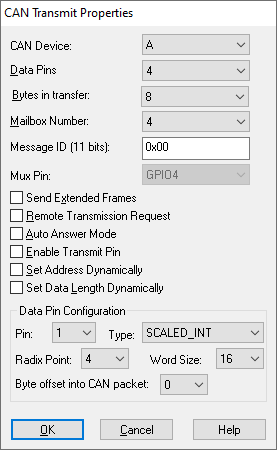
Target Category: C2407, Cortex M3, Delfino, F280x, F281X, Piccolo, STM32
Target Sub-Category: CAN
Description: The CAN Transmit block implements a controller area network (CAN) version 2.0. This block generates code to transmit up to four 2-byte integers from a CAN bus. Use CAN Config to configure the network.

Auto Answer Mode: Only for boxes 2 and 3.
Data Pins: Controls the number of 2-byte integers to be transmitted.
Byte Offset into CAN Package: Specifies the byte offset into the 8-byte packet. Offset 0 starts with the first element in the packet.
Pin: Indicates the pin to be configured.
Radix Point: Sets the binary point.
Type: Specifics the data type. Scaled_Int is 16- or 32-bit, depending on word size.
Word Size: Specifies the word size in bits.
CAN Device: Indicates the CAN device.
Enable Transmit Pin: Allows the transmission to occur. This option must be activated.
This option adds an input pin to which you present the CAN address to which you want to transmit.
Mailbox Number: Represents a hexadecimal number used to mask off a portion of the identifier that would normally be used to match a CAN message identifier.
Message ID: Indicates the CAN message ID used to specify the network address.
Mux Pin: Selects the pin which a given function is on.
Note: Some F280x and MSP430 devices have different functions for the same physical pin on the chip. This is referred to as multiplexing, or muxing, for short, and is done because pins are expensive. Because multiple functions compete for a given pin, you must choose what function a pin has. For flexibility, in some cases Texas Instruments provides multiple possible pins for a given function. For instance, the CANTXB function can be on pin 8, 12, or 16. Pin 8 is shared with ePWM5A and ADCSOCA0; pin 12 is shared with TZ1 and SPISIMOB; and pin16 is shared with SPISIMOA and TZ5. If you want ePWM5A on a pin, you cannot use pin 8 for CANTXB, but rather pin 12 or 16.
Number of Inputs: Controls the number of 2-byte integers to be transmitted.
Remote Transmission Request: Sends non-data packet to message ID. If the box at message ID is in auto answer mode, it uses an immediate response.
Send Extended Frames: Allows use of 29-bit identifier.
Set address dynamically: Changes address to transmit to as the algorithm runs.